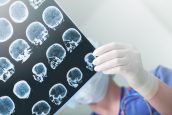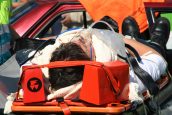Head, Spine, and Traumatic Brain Injury Attorneys Serving Clients in West Long Branch, Red Bank, Tinton Falls and across the Monmouth County area.

A traumatic brain injury is a blow to the head or a blunt force that disturbs the regular function of the brain short- or long-term. Usually, TBIs result from the swift striking of the head against an object, as would happen in an automobile accident when the head hits the seat or airbag.
Traumatic brain injury is categorized into mild, moderate, or severe, depending on the force of the blow the victim received; however, a mild injury can still have lasting and serious effects, so it is important to seek medical support if even mild symptoms begin to show after the impact.
The American Association of Neurological Surgeons (AANS) reports that around 1.7 million cases of traumatic brain injuries occur in the United States annually. A 2010 report by the U.S. Department of Health and Human Services National Center for Injury Prevention and Control showed that automobile accidents account for 50-70 percent of TBIs in the United States. The report continues that between 2002 and 2006, nearly 219,000 emergency room visits resulted from automobile-related TBIs.
What are the symptoms of a TBI?
According to the Mayo Clinic and the AANS, symptoms of traumatic brain injury, even in mild cases, may include the following:
- Temporary loss of consciousness
- Temporary physical or mental disorientation
- Sleepiness or lethargy
- Headache
- Upset stomach or throwing up
- Irregular sleep patterns
- Seizures
- Mild to severe vertigo
- Disturbance to your senses of sight, taste, hearing, smell, and touch
- Sensory sensitivity
- Difficulty focusing
- Emotional irregularity or agitation
- Temporary paralysis
- Dilated pupils
- Difficulty breathing
In more severe cases, a TBI may cause result in a coma, altered state of consciousness including loss of consciousness, or even brain death.
What are other common causes of TBIs?
The Mayo Clinic reports that, in addition to automobile accidents, traumatic brain injuries often occur as a result of falls from heights, violence, sports-related injuries, and explosions of varying types.
Seek medical attention immediately after a head injury

As noted, symptoms of a TBI may appear mild, but they may point to a deeper wound that could have dangerous and lasting effects. One such silent danger is a mass lesion, an acute area of injury that may at first not cause symptoms but that may result in a buildup of pressure on the brain. Another localized injury that must be addressed immediately is a blood clot – also called a hematoma – or bruise resulting from a TBI.
There is no immediate ‘cure’ for a traumatic brain injury, and a doctor will focus treatment on limiting secondary ‘insults’ of a TBI, developments directly related to the original blow that could cause long-standing neurological injury. This prevention of further neurological distress is a primary goal of medical treatment following a TBI.
Contact a Monmouth County New Jersey Head, Back and Neck Injury Attorney Today
If you have been in an automobile accident and have experienced any of the above symptoms, please seek medical attention immediately. Then reach out to a member of our experienced team of personal injury lawyers to schedule a consultation and ensure that your legal rights to recovery for accident damages are upheld.
If someone is seeking compensation for a traumatic brain injury, the hiring of an experienced lawyer is vital. A qualified lawyer at Chamlin, Uliano & Walsh specialist in traumatic brain injury issues is able to help you gain compensation from those causing the injury. Many times such cases involve issues of medical negligence. The attorneys at our office know how to deal with these situations.
For personalized information as to how these Monmouth County Brain injury attorneys can assist you or someone you love. Contact the West Long Branch, New Jersey office of Chamlin, Uliano & Walsh at 732-440-3950 or toll-free at 888-328-9131.
